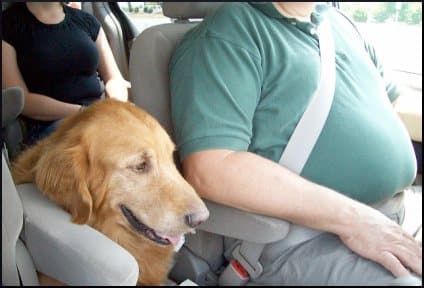
Richard French, DVM, M.S., Ph.D., of Becker College (where he is a veterinary pathologist and Dean of Animal Studies) is very concerned about obesity among pets. There is a lot of it. American households contain 77 million dogs, of which 53% of the adult dogs are overweight or obese. Out of 93 million domesticated cats, an even larger proportion of them are overweight. In both cases, cats and dogs, fat pets make up more than half of their total populations.
For centuries, observant people have noted that pets tend to look like their owners. Artists have gotten a lot of fun out of this quirk, which has even been scientifically verified. Unfortunately, the resemblance can extend to weight problems. Usually, an overweight pet signals the presence of an overweight owner, and vice versa. Both can develop high blood pressure, osteoarthritis, and other obesity-related conditions. Fat pets have joint problems and need expensive surgery. They don’t get much fun out of life and neither, after paying the bills, do their human companions.
At the Food and Drug Administration, the Center for Veterinary Medicine is also concerned. The American Veterinary Medical Association is not happy either, about the tally of overweight pets reaching more than 100 million. Part of the problem, they all agree, is that the overweight or obese pet owners probably don’t view either their own shapes, or those of their pets, as being excessively large. We have heard this saying many times before — “Fat is the new normal.”
Pet owners who are not parents often see their pets as their children, and derive a lot of joy from feeding them treats. If they have both pets and kids, watch out! Dr. French sees heavy pets as a red flag. If there are also children in the household, they probably overeat too. He says:
Pets are family members, and we often treat them as loved ones, with all the benefits of a great home life. But our pets are, sadly, falling victim to one of the biggest health issues facing their human owners.
Think about the lifestyles of many of our young people, and then we can readily see how their pets are emulating those lifestyles. If a child is playing video games all day, the dog isn’t outside playing. Rather, the pet is sitting at her feet or on the sofa. If the child is lying around snacking on high-calorie treats, chances are the dog is sharing in those same excess calories — and is also likely to get something from the dinner table.
Kathy Santo, an advice columnist for Good Housekeeping magazine, once answered a reader’s question about a constantly hungry 18-month-old Pomeranian dog that would eat anything, including their other dog’s food and waste products. Santo wrote:
Have you had her medically checked out? I’m not talking about a quick vet check. I’m talking about a complete workup so you can rule out Cushing’s, adrenal problems, hypothyroidism, liver issues — all of it… [B]e sure to do that first.
Your responses and feedback are welcome!
Source: “Overweight Owners Lead Pets to Obesity,” PR Newswire, 05/08/13
Source: “Why Does Your Dog Overeat?,” Good Housekeeping, 01/22/08
Image by kniemla.

 FAQs and Media Requests:
FAQs and Media Requests: 












One Response